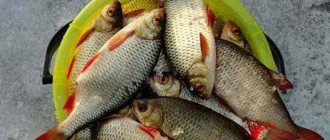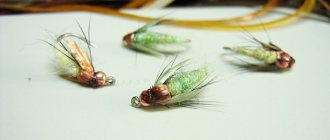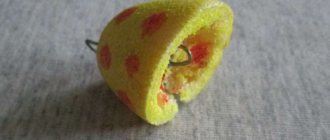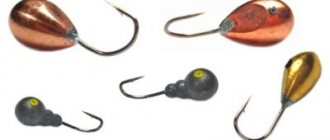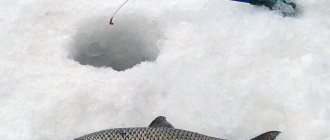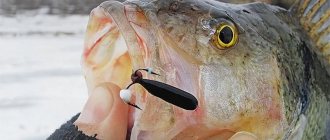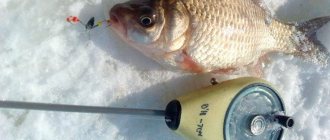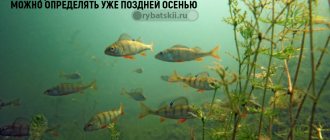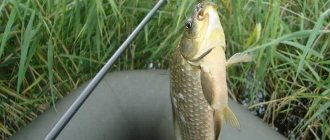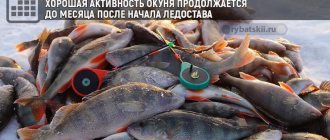Winter fishing allows you to enjoy the fishing process from start to finish. After all, the fisherman takes part both in the process of drilling holes and in the fishing process, which is characterized by rather active actions of the fisherman.
Any winter fishing brings a lot of fun, including catching rudd. The fact is that preparing to catch a specific type of fish is always more difficult, so the result is always desirable. Naturally, it’s easier to go fishing, drill a hole, throw tackle into the hole and wait for some fish to bite.
Catching rudd requires knowledge in terms of where to catch them, when to catch them and what to catch them with. Without knowledge of the behavior of this fish, effective fishing will not work.
Where to look for rudd in winter
Rudd will be caught in winter when the conditions in the reservoir are sufficient for this. If it is a large body of water, with significant depths, without shallow areas with thickets of reeds and sedges, the rudd is unlikely to become active. In such conditions, she simply hibernates, and you should not count on her biting.
Therefore, shallows with the presence of last year’s vegetation are considered the favorite places of this fish. For many other fish species, such places are not promising, but for rudd this is what is needed. If you see a crowd of fishermen in such places, this means that they are hunting for rudd.
Therefore, a promising place for catching rudd is in areas of the reservoir no more than one meter deep, where remnants of reeds peek out above the ice surface. Fishing in such places is quite difficult, because most of the vegetation is under water. This leads to frequent hooks and breaks in the gear, but this factor does not stop fans of winter rudd fishing.
Since the depth is not great, the rudd hears everything that is happening on the surface of the ice, especially after a hole has been drilled. It is possible that she will leave the hole for a certain time and will be able to return to her original place if silence is maintained.
Some anglers drill several holes and begin to fish them one by one. At the same time, you should move very carefully. You need to be prepared for the fact that after lowering the gear into the water, bites may follow within 10-15 minutes.
Winter fishing for rudd. Anglers' recommendations:
• Rudd loves silence, so you should not stomp on the ice or talk loudly in fishing areas. • With finicky rudd, it can be very difficult to guess the best jig shape, so you need to have several different lures with you. • Bloodworms are considered the most catchy and versatile bait for rudd in winter. • After drilling a hole, the fish, frightened by the noise, will begin to bite in about half an hour. During this time, it is easy to drill and feed another 5-7 holes. • When catching a large specimen, you should not rush to fish it out - you need to let the fish get tired, and then calmly drag it onto the ice. • The interval between bites can be several minutes - the flock must calm down and again approach the baited fishing point. • You should catch no more than 10 fish from one hole, after which you need to change the place.
Winter fishing for rudd is a fun and interesting activity. But the capriciousness of this fish regarding bait, fishing time and weather conditions make it not very attractive to most winter fishing enthusiasts. A thorough study of the habits of this fish will help bring success, after which fishing for rudd from the ice will turn into a real pleasure.
What do you use to catch rudd in winter?
You can catch rudd in winter using both natural bait and jigs. The most common baits are:
- burdock fly larva;
- amphipod larva;
- caddis larva;
- bloodworm;
- maggot;
- small brown leech.
Most fishermen use the most accessible and fairly catchable baits, such as bloodworms or maggots. Other baits are used less frequently due to the difficulty of acquiring them. In addition, bloodworms and maggots have very acceptable catchability, which satisfies many anglers.
In addition to this method, you can use the traditional winter method - fishing with jigs. To catch rudd, jigs no larger than 3-4 mm in size are suitable. In clear weather, it bites well on flesh-colored baits, and in cloudy weather it prefers brighter colors. Oddly enough, shiny jigs worsen the bite of rudd. Therefore, you can count on results when using baits in matte shades.
Depending on weather conditions, rudd may be interested in a bait of a certain shape. Therefore, when going winter fishing, it is better to have a whole set of jigs that differ in shape and color.
Fishing with a nod rod
The peculiarity of catching rudd in winter with a nod-type fishing rod is that the angler is constantly involved in the process. This method is more common in winter frosts. According to reviews from most fishermen, fishing with a jig gives a greater effect. However, it is necessary to take into account the specific behavior of fish for a particular reservoir.
Rig a tackle with a nod
The set of tackle with a nod includes:
- a nod-type fishing rod, with a sensitive and long nod;
- fishing line 0.08-0.12 mm thick (it is desirable that it is not too noticeable in the water);
- jig - a small 4 mm model is enough. Most often, jigs with a bloodworm attachment are used, but sometimes they use non-moth baits.
What jigs to use for rudd
When catching rudd in winter with an artificial jig, it is best to choose 3–4 mm baits. If the weather is cloudy, it is advisable to choose a brightly colored bait. In sunny weather, rudd bite well on a flesh-colored jig. You should give preference to matte baits: with shiny jigs the bite is worse. Depending on the weather, rudd can react to jigs of different shapes. Therefore, it is advisable to have with you a set of attachments that differ in shade and configuration.
The following types of jigs are most often used to catch rudd:
- crap;
- a drop;
- nymph.
The “Devil” jig works great solo or in combination with other types of bait. The rudd bites best on the last or, conversely, the first ice. Can be used both in running water and in standing water.
“Drop” is a classic universal option that is suitable for various types of reservoirs. Most often, it is used in wilderness areas. This type of jig for rudd gives good results with baits of animal origin.
"Nymph". Its area of application is reservoirs with running water, where many insects live, in particular the caddisfly. It has proven itself well when fishing in creeks.
Jig fishing technique
In winter, the rudd is especially careful and timid. Therefore, playing with bait should be smooth, excluding sudden movements. The playing technique is the simplest. Slowly lower the bait to the bottom, shaking it slightly from side to side. If the fish is active enough, it will react even to a bait that stands motionless in the water.
Best time to fish
Unlike other types of fish, which can be caught throughout the day, with a short break for lunch, rudd bites only in the first half of the day. Counting on her to bite after lunch is a waste of time. If there are frosty days outside, then going fishing with the hope of catching a rudd makes no sense. During this period, it will lose its activity or go to depths, where it will be warmer.
When the temperature outside begins to approach zero or a slight minus, the rudd returns to its favorite places. Most likely, this is due to the fact that oxygen enters the water through vegetation that breaks through the ice. Therefore, in such places there is more oxygen in the water and the fish behave as actively as in summer.
Although the rudd resists, just like in the summer, its strength is not enough to prevent the angler from pulling it out of the hole or damaging the tackle.
Despite this, there is a possibility of catching a large specimen, weighing up to 1 kg. You need to be prepared for this and when fishing, do not rush or make sudden movements.
Tips for Maximum Catch
- You should go fishing for a big catch early in the morning, as soon as it begins to get light, the whole point is that capricious fish are caught only until lunch, then they stop biting.
- Make several holes in advance, and throw fertilizer into each of them; when all the holes are made, return to the very first one.
- In extreme cold, most likely there will be no catch or bites. The rudd, escaping from the frost, tries to go as deep as possible, its activity decreases significantly.
- There is no point in sitting in one place in the hope that the fish will bite anyway. It's better to look for other better places.
- After catching one fish, wait a couple of minutes for the water to calm down and continue in the same spirit. Rudd is a schooling fish; once you catch one fish, the chances of catching other fish increase.
Winter tackle for rudd
Some anglers use winter fishing rods with a nod, while others use a float so as not to sit above the hole. Therefore, what to catch rudd in winter depends on the choice of the fisherman.
And although the rudd loses practically little in terms of activity in winter, it does not have such strength as to break the tackle. At the same time, it should be remembered that the thinner the line, the more active the bite can be. If you have some experience, then on a fishing line 0.05 mm thick you can pull out a fish weighing about 1 kg. At the same time, it should be remembered that fishing in such places can bring a lot of hooks, and these will certainly be cliffs. To minimize breakages, anglers use fishing line with a diameter of 0.18 mm. This approach will not only reduce the likelihood of cliffs, but will also help in case another, more powerful fish bites.
Lead-colored or brown jigs have worked well. Experimental casting will help you find a catchable bait. At the same time, it should be remembered that in clear weather, rudd takes dark baits better, and in cloudy weather, brighter ones.
When choosing a method for moving a jig, you should make your choice on smooth, slow movements. As experience shows, sudden movements are contraindicated.
Jig for rudd in summer from a boat
Often, rudd can be easily detected by frequent splashes of water, although their absence does not mean anything. That is why it is necessary to fish all promising areas that are encountered along the way. They row up to the stopping place as carefully as possible, and start fishing with a previously prepared fishing rod.
In most cases, they are caught in a sitting position, but sometimes this becomes impossible due to high vegetation. Then, if the craft is sufficiently stable, they stand up. The bait drops quickly, at a right angle, which is easy to do thanks to the short line. The nod is closely monitored in order to have time to throw the equipment when hooked.
To achieve the necessary accuracy, you have to practice a lot, but your efforts will be more than compensated by a good bite. If you manage to accurately deliver the bait, the bite follows immediately, and it is so greedy that the fish swallows the hook. Sometimes you can see how the fish jumps out of the water in an attempt to reach the bait in the air.
Unfortunately, a flock frightened by something can quickly move away from the dangerous area, and patiently dipping the tackle in anticipation of the next bite is useless. In this case, it is necessary to find a new catching place, continuing to move across the water area and exploring the thickets.
By the way, such fishing brings success not only in catching rudd, but also roach and silver bream. In this case, it is necessary to change the descent of the line, since the bait should be located at the very bottom, fishing areas not only among dense vegetation, but also coastal thickets, which is especially important in strong winds.
Lure
The use of bait when fishing for rudd is absolutely justified, as it increases the number of bites. Rudd may be attracted by a cloud of turbidity that appears at the bottom of a reservoir. Considering the fact that the depth is not great, you can take a stick and reach the bottom with it to organize this mess.
Any porridge or ordinary poppy seed will serve as bait. The bait is poured into the hole in small portions so as not to alert the fish.
Winter fishing not only brings a lot of pleasure, but also poses danger. Under no circumstances should you ignore the rules of behavior on ice, especially when it is not yet strong. You will never catch all the fish, but swimming in cold winter water is easy. Therefore, you should always listen to the recommendations of those services that have information about the condition of the ice surface. If they warn of danger, they should not be ignored.
Baits and baits
Catching rudd in winter with a jig will be primarily done with natural baits, while it can also bite on plant baits, as well as on a reelless jig.
Baits
Of the baits, the most preferable is bloodworms - the best winter bait, which is also sold in all fishing stores. On some reservoirs, hobbyists successfully wash mosquito larvae themselves, and “their” bloodworms, as a rule, live longer.
And it’s also easy to buy maggots in the store. In this case, it is advisable to choose a jar with multi-colored larvae; the fish may be capricious and prefer one of the colors.
A bait such as a burdock moth larva works well, especially in deep winter conditions. It is not available for sale, but if you are not lazy, you can prepare it in sufficient quantity, especially since this bait is stored very well in the refrigerator.
Inside the prickly cones is one of the favorite baits for winter whitefish.
Note that you can catch rudd in winter using other, less popular baits:
- amphipod larva;
- small leech;
- dung worm.
Nozzles
The best vegetable attachments are dough and semolina. Quite good results, and canned corn can produce trophy rudd.
It is best to flavor dough and semolina with unrefined vegetable oil. However, when adding it to the bait, you should adhere to the principle of minimality; an excessively strong smell will scare away the fish rather than attract it.
Fishing methods: equipment
Considering the fishing locations, which are usually windows in dense thickets of aquatic vegetation, the tackle should combine maximum strength (based on the average size of the fish) and be invisible to the fish.
The standard tackle for catching rudd is a float rod (Bolognese)
Moreover, it is important that it is as sensitive as possible
The optimal line is considered to be a fishing line with a diameter of up to 0.17 mm on the base and 0.1 - 0.12 on the leash, a feather float, a shot and a hook No. 3-4 or a small jig.
In many regions, rudd are caught using tackle without a sinker. In this case, the bait mounted on a hook or jig slowly sinks to the bottom under the weight of its weight. In winter they are caught using a regular fishing rod with a small jig.
The fishing method depends on several factors:
- place of fishing;
- season;
- activity;
- nozzle;
In winter, the main way of catching rudd is by ice trolling with various jigs such as crescents, pellets, and others that imitate flies and insects.
In spring, summer and autumn, a float fishing rod is used. They are most often caught in half the water or at a depth of 40-80 cm. They usually fish in fish habitats. Since she leads a sedentary lifestyle. And it moves away from its favorite places only during morning and evening exercise in search of food.
In reservoirs with weak currents, fishing with a wire is successful. And on heavily overgrown lakes and bays, use a jig without a float to plumb. In the latter case, the rod is instead equipped with a nod or a rubber shock absorber.
In some areas, ultralight spinning rods up to 2 meters in length are used, with a dough of 5-10 g, equipped with small rotating spoons.
When to catch
There is an opinion that rudd bite best during the thaw and only before lunch. This is only partly true; in fact, fish can be caught even in frost and throughout the day. The only thing we can say with certainty is that the weather should be stable for several days. In general, you need to try fishing any day, in case something happens. Unfortunately, it is not possible to make custom weather for the weekend.
Of course, on the first and last ice, rudd, like any other fish, is caught better than in the dead of winter. Although in the first thaws in mid-late February you can go fishing.
The best tackle for catching rudd from under the ice is considered to be a jig rod with a nod. Using a float is not so convenient, because for the most part you have to fish not from the bottom, but in the water column.
The equipment is mounted on a regular winter fishing rod. It can be either a balalaika or a filly. The type is not so important, the main thing is the convenience and habit of the fisherman himself.
The fishing rod is equipped with a thin fishing line, the maximum diameter of which should not exceed 0.12 millimeters. Monofilks of 0.08–0.10 will be optimal.
We select the nod according to two parameters:
- it should provide the required deflection under the weight of a light jig;
- the game should be smooth and measured.
Therefore, it is best to use lavsan nods about 10–15 centimeters long. For better visualization of wiring and biting, it is advisable to apply black and (or) red stripes to light plates.
Jigs for rudd should be small, and the shape does not matter much if we are talking about the attachment version of the tackle. Small baits are better in several respects:
- Firstly, they do not unmask the equipment; it is the bait that stands out against their background, and not a piece of metal.
- Secondly, more bites are realized on a small jig; there are practically no idle bites. This happens because the fish, along with the bait, sucks the bait into its mouth.
- Thirdly, with a light bait the movement of the bait looks more natural to the fish.
Bait for rudd and how to use it
It is advisable to feed any fish before fishing and regularly feed it during the process. Rudd is also a fish and is no exception to the rule. But since it is a riding fish - it is most often necessary to catch it in the upper layers, it is not advisable to lower the balls with bait to the bottom.
In shallow water up to 1 m, this is still permissible, especially if the bait contains effervescent geysers that eject particles of the composition to the surface. Therefore, the starting bait is made purely symbolically in 2 - 3 portions. The bait kernels are formed in a small shape, the size of a table tennis ball, and are thrown instead of catching rudd regularly throughout the fishing. Before starting fishing - 2 - 3 pieces, and during the process - one at a time. How often to add bait depends on the intensity of the bite.
But, to be sure that the rudd will pay attention to our luring agent, after hitting the water it must disintegrate into small particles, forming a column of “tasty” turbidity. And for this to happen, the composition of the bait must be loose and not very moist.
Sticky components: flour, breadcrumbs, starch, etc., are not added to the bait for top fish at all, otherwise it will not be viscous, and its solid balls will fall to the bottom and will be of no use. Instead of flour and crackers, we will use bran (any kind), and also add ingredients with a low specific gravity that have good buoyancy due to low water permeability. They will provide the effect we need.
These ingredients include: ground sunflower seed shells, hemp seeds, finely ground sunflower seeds, coconut flakes, cocoa, milk powder. For scent, you can add anise, coriander, vanilla or any other flavor that the rudd likes. If the mixture turns out to be too light, and instead of a column of particles, a spot will form on the surface of the water, then you can add a little coastal sand.
You can, for the first time, buy bait in the store, but it is rare for rudd, so we take the composition for roach and add coconut flakes, ground sunflower seed shells, a little dry milk, a little dry river sand to it. Do not add it under any circumstances. mix clay or soil, and do not over-moisten the mixture.
It should form with difficulty when squeezed and immediately crumble in the water. Try the prepared composition, form a ball out of it and throw it into the water near you; if it crumbles immediately after immersion, the bait is ready; if it hasn’t crumbled, it means it is waterlogged and needs to be added baking powder - bran or dry sand. Ground seed shells will not immediately absorb moisture, which makes it quite difficult to regulate the consistency of the bait mixture.
And in order to learn how to easily prepare bait yourself, you need to understand the properties of its main components and know them. The following articles will help you with this: “Composition and method of preparing feeder bait”, “Bait for fishing”.
Fishing luminaries - fishermen of the old era, do not bother too much with the composition of bait. They feed the rudd with boiled millet or barley, or assorted porridge of cereals; pearl barley, millet and barley, flavored with vanilla or anise and, you know, they are caught no worse than others, although logically the fish should quickly fill up, but I think it is replaced by another - hungry, not yet having had time to taste their grandfather’s “pickle pickles”
The bait for rudd is not particularly sophisticated. A couple of handfuls or one bowl of soaked sunflower cake - makukha - is enough. Add a small handful of canned corn to it. The corn needs to be chopped or mashed so that there are no large grains. Mix well with the flour.
Catching rudd with a float rod
It is considered the most productive, and therefore the most common, method. Large rudd are caught far from the shore, using float tackle for long casting - match. It can be used with a special match rod, but just because of the rudd, it’s not worth buying it specifically.
Instead, you can easily get by with a long - 5 - 6 m Bolognese telescope, equipped with match equipment. The main thing for this equipment is to have special long-range match floats, without them the tackle for long casting will not work, and an inertia-free high-speed reel of size “3000”.
Once again I will not describe match tackle and other float rods, for those interested here is a link to an article about all types of float rods: match, Bolognese, fly and plug, with a detailed description and characteristics of the rods themselves, features and differences in the principle of their operation and characteristic elements for these gears.
Rod material - carbon fiber or composite. Length 5 m - 6 m. Bait weight test - 18 - 30 g. Rod structure - rigid. The reel can be used either an inertia-free reel of any size “2500” - “3000”, or an inertial open type with a diameter from 70 mm to 150 mm.
You can catch rudd near the shore in shallow water up to 1.5 m using a regular float rig, or you can do without a reel if you use a fly rod. This method, of course, significantly limits the fishing distance, but has some advantages if there are enough fish near the shore. A fly rod is very suitable for catching rudd from a boat at a shallow depth of up to 1.5 m - 2 m; nothing else is needed.
It also happens: The method of catching marinka
When and where to catch rudd
Rudd does not like currents, so you should always look for it in low-flowing ponds, lakes, oxbow lakes and backwaters. Throughout the warm season, when the water is freed from the shackles of ice, you should look for rudd in shallow water, in thickets of algae and reeds. Often fills windows between thickets of aquatic vegetation. In one such window you can catch more than a dozen of this fish.
Rudd is caught exclusively during daylight hours. It bites throughout the day, without taking a break even at lunchtime. Like the bite of any other fish, the bite of the rudd becomes more active in the morning and evening dawns. Morning dawn is the most catchy period of time when catching rudd.
The rudd collects fallen butterflies and various mosquitoes from the surface of the water, which often reveals its presence. You can often notice how a bug that has fallen into the water is immediately grabbed by “someone” from under the water; one can easily assume that it was a rudd.
Sometimes rudds reveal themselves in the evenings when they grab flying insects from the surface of the water. You can see how their golden sides sparkle, which means it’s clear where you should stop with your fishing rod. From under the wide belt of reeds, rudd are best caught from a boat. I anchor about 15m from the reed beds and cast my baits 1m to the first stems.
The combination of red corn with strawberry flavor (from Pescaviva) and yellow maggots also worked well. Another bait I trust when catching rudd is breadcrumb pieces. The bread crumb is unsurpassed on ponds where passers-by constantly feed the ducks. There is enough bread left for the fish, and they have become accustomed to this extra food.
Catching baits
Since rudd are fish that readily take food from the surface, they can be caught using drifting bread crumbs. It is best to throw a few pieces of bread crumb into the water before fishing while walking along the shore of the reservoir to see if the rudd are interested in the bait.
[THERE IS AN ANSWER] Which fishing rod is better for bottom fishing
If you are interested, use a hook with an attachment made from a piece of bread crumb. A carp controller serves as a casting weight. Rudds swallow midges and other insects from the water surface. Therefore, it would be good to try to catch these “gold bars” with grasshoppers. A water ball will provide the necessary mass for casting here.
Floating baits
When fishing for rudd, the bait should sink very slowly. Therefore, it should be given a little buoyancy. This is best done using artificial maggots, artificial bread and foam rubber. You will need a buoyant body that will allow the bait to float only slowly and balance the mass of the hook.
Critically balanced (balanced almost to neutral buoyancy) is what the British call this bait. So, the hook must sink as slowly as the portions of loose bait, otherwise the rudd will become suspicious. When it comes to making baits buoyant, your imagination knows no bounds. You can take a piece of foam from Ohropax earplugs, plastic maggot or caster (Balzer), a piece of artificial bread crumb (Enterprise Tackle) or foam rubber of various colors.
Most often, buoyancy is adjusted using scissors so that the bait really slowly sinks to the bottom. It is advisable to check in shallow coastal waters whether the desired effect is actually achieved. Floating bait near the float rarely brings bites.
Rudd on a fishing rod in overgrown places - classic fishing
The rudd is very numerous, inhabits many reservoirs that are not poor in oxygen, and is caught by almost all fishermen with a fishing rod. Sometimes it is a passing catch when catching other fish. Sometimes it is caught purposefully, special gear, bait,… are created for catching it. Catching rudd with a fishing rod is interesting and exciting, athletes train on it...
Where and how does the rudd bite?
In open water, active rudd biting begins at the end of April. The fish are caught all day long, and gather very closely in the feeding area.
In large reservoirs with a rich food supply, river mouths, and estuaries, the rudd reaches more or less impressive sizes, and its catches on a float rod can amount to tens of kilograms.
In April - May, rudd are mostly found in shallow water, in places where the water warms up faster. At this time, you need to choose a fishing place with a depth of up to 1 meter, preferably overgrown with “grass”, and it is better to catch rudd from the bottom. In summer, it is preferable to fish at depths of 1 - 2 meters, with the hook placed 0.5 - 1 meter from the ground, although even at this time the rudd can perfectly take not only a floating bait.
Rudd on a fishing rod in overgrown places - classic fishing
The fishing rod should be light
For catching rudd, the most suitable tackle will be a fly rod. It is optimal to choose the following:
- the length of the rod is 5 - 6 meters, and for wading fishing in weeds - 4 - 5 meters,
- main line – 0.1 – 0.12 mm,
- leash – with a diameter of 0.08 mm and a length of 10 cm,
- float with a load capacity of up to 1.0 grams, for long rods and windy weather - up to 2.5 grams,
- loading - 2 - 3 weights, hook - under a bloodworm made of thin wire.
With such a light and elegant float, provided it is loaded correctly (only the antenna should be above the water, and the floating body is completely immersed in the water), the slightest bite will be noticeable.
Coloring the floats and selecting the hook
It is necessary to have floats with different colors of antennas, and use them depending on the lighting and fishing conditions. This greatly reduces visual fatigue and makes fishing a complete relaxation. For example,
- for a dark background of water, a white antenna is good,
- for a background that glares in the sun - black,
- for the wave – red-orange.
The hook is used with a straight tip, made from the thinnest wire. The size of the hook rather depends on the type of bait, because the rudd boldly takes large hooks. For bloodworms No. 20, for worms - No. 15, for a slightly smaller dough - No. 16-17. It is recommended to prepare a set of leashes with hooks at home so that you can quickly adapt to the fishing conditions and the mood of the fish.
Rudd is better caught with bait
Fishing for rudd is usually carried out by feeding the place. You can use store-bought bait, but if you have the time and desire to prepare food at home, you can use this simple recipe:
- 1 part breadcrumbs,
- 1 part ground sunflower cake (or preferably ground roasted seeds),
- 0.5 parts ground oat flakes,
- It’s a good idea to add something dusty and buoyant, at least wheat bran...
You need to add the bait you are using into the bait - bloodworms, chopped worms, pearl barley. It is advisable to flavor the bait; for example, the following flavors work well: strawberry, duchess, coriander, anise. Soil, ground through a sieve and added in small quantities, will change the color of the bait, add turbidity and make the bait more durable.
You can mix the ingredients at home, but you need to moisten the food only with water taken from a reservoir, with a fish-like odor. Bleaching impurities in water are simply unacceptable.
Bait and catch
Various doughs, bread crumbs, bloodworms, worms, and pearl barley work well as attachments. Moreover, it is advisable to use the same flavorings for the test baits that were used to prepare the bait.
[THERE IS AN ANSWER] How to make a winter fishing rod with your own hands?
To soak bread crumbs, it is better to use water from a pond. To prepare dough and cook various recipes, it is better to use purchased water or water from a spring. Such seemingly trifles have a significant impact on the final catch, and the rudd’s fastidiousness is only apparent.
When fishing, it is very useful to experiment and not settle on one thing. If the bite weakens, try changing the depth and changing baits. It is better to start catching rudd from the bottom, then fish in half the water. It is useful to periodically throw small pinches of food or a few pearl barley into the fishing area. This creates excitement in the school, and the fish takes the bait more confidently. And the rudd will not leave you unattended, and a great mood will come with it.
Constant feeding is a bit of a tedious process. But only a good dose of dusty, dry bait that creates a cloud creates a good stir and the fishing goes on confidently...
You can watch the video “Fishing in the Nizhny Novgorod Region” online in good quality on our website for catching rudd with a float rod in the summer in June on Lake Obukhovo, near the village of Memory of the Paris Commune. Enjoy watching!
You can watch the video “Fishing in the Nizhny Novgorod Region” online in good quality on our website for catching rudd with a float rod in the summer in June on Lake Obukhovo, near the village of Memory of the Paris Commune. Enjoy watching!
Searching for and catching rudd with a float rod in the channels between lakes. In the morning, after feeding the place, we started fishing with a float rod. The bites started right away, but the size of the rudd was not encouraging. After changing many places and giving up bait, we found and began to catch a large rudd.
The equipment must have a leash made of fishing line with a cross-section of 0.12 mm, a hook No. 3-4, with a short fore-end. It is recommended to install the sinker at a distance of 20-25 cm from the hook; if fishing conditions allow, then the distance can be safely increased.
Where to look for her
It should be noted right away that you need to go winter fishing for rudd in the body of water in which it is successfully caught in the summer. These can be either individual lakes with running water or quiet bays of large and medium-sized rivers.
The second important condition is the presence of higher aquatic vegetation in the reservoir. The rudd gravitates specifically to the underwater jungle, unlike the same roach. It is found where they grow:
- reed;
- cane;
- cattail;
- other similar plants.
In addition, rudd, unlike roach, is a pelagic fish, that is, it prefers to feed in the water column rather than rummage in the bottom silt.
And it should also be added that in winter, fish stand in shallow places near plants because natural air exchange occurs in places where the stems pass through the ice. At the same time, schools of rudd do not stand still, but ply in a small water area, so you should first find several sites, and then try to keep them with bait.
